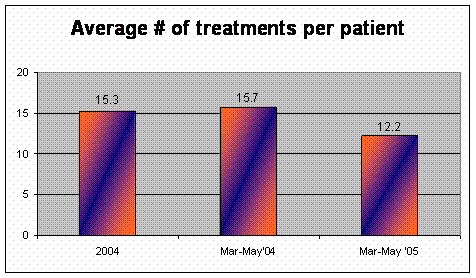
LEVALBUTEROL STUDY CONFIRMS PREVIOUS DATA.
John Wolfe, RRT, CPFT, Edward Amend, BS, RRT, Tod Cunningham, BA,
RRT Northern Colorado Medical Center, Greeley, CO.
Background: Previously presented data regarding
the use of levalbuterol demonstrated a 24% decrease in total
treatments (Pikarsky 2002). At North Colorado Medical Center,
Greeley, CO a 300 bed institution, we wanted to determine if we
would experience similar results.
Method:
After consultation with the pharmacy department and approval from
the Pharmacy and Therapeutics Committee, we undertook a three month
trial substituting levalbuterol at Q8 and Q4 PRN intervals in place
of racemic albuterol or racemic albuterol and ipratropium, which had
been administered at QID or Q4 hour intervals. Our analysis
evaluated data for all non-ventilated patients; it excluded
pediatric and emergency department patients.
Results: The average number of treatments
required per patient stay decreased by 22%, from 15.7 to 12.2:
2004: 11,761 treatments ÷ 741 patients = 15.7 average #
treatments per pt
2005: 11,626 treatments ÷ 956 patients = 12.2 average #
treatments per pt
Prior to the study period, the average number of treatments per
patient stay was 15.3 for all of 2004, and 15.7 for March through
May of 2004. The lower mean number of treatments with levalbuterol
compared to racemic albuterol (15.7 vs. 12.2) represented a 22%
reduction in breathing treatments per patient stay.
Additionally, the total number of treatments for the three month
period (had levalbuterol not been) used was decreased by 28%:
15.7 (2004 average) x 956 (total pts for 2005 period) = 15,009
(projected)
Total treatments 2004 = 11,761 (actual)
Difference = 3,248
Conclusion: Our data is consistent with the 24%
decrease in treatments demonstrated in the Pikarsky study. An added
benefit was that many patients were able to enjoy eight hours of
nocturnal sleep time without interruption for breathing treatments.

Chart 1. The average number of treatments per patient stay
decreased by 22%, from 15.7 during March-May 2004, to 12.2 during
March-May 2005. |



